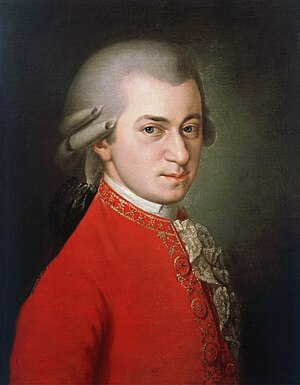 Image via Wikipedia
Image via Wikipedia(Text in large print for classroom projection)
Homophony and clarity of melody
Balance and proportion
"Naturalness"
Symmetry
Clarity
Elegance
More contrast
Melodies simplified and less ornate
Folk music influence
Twinkle Twinkle Little Star by Mozart
http://www.youtube.com/watch?v=qGln8LFA8Qw
"Ah! Vous dirai-je, Maman" Twelve Variations by Mozart
Music was considered the "language of the heart"
Major Composers
http://www.youtube.com/watch?v=c-crzq1PX4A
Joseph Hadyn
Amadeus Mozart
Musical Developments in the Classical Era
Theme and Variations
Minuet Form
Symphony
Rounded Binary Form
Rondo Form
Sonata Form
Cadenza
Crescendo
Decrescendo
Harpsichord less used
More tone color
Style Gallant (musical counterpart to the rococo style in art. Used by composers in the late Baroque, like Bach's sons). Light and graceful (similar to rococo art's lighter touch and softer lines).
Contrast was increased greatly in the Classical Era. Contrasts in mood, dynamics, instrumentation, etc. Textures changed often.
The orchestra began to be standardized, with a set number of strings, woodwinds, brass, and percussion. The number of musicians in an orchestra could change.
Rhythm had more variance. Syncopations and pauses.
Music was primarily homophonic. The melody gained importance again. Polyphonic lines were rarely, if ever, used. No more improvisation on the basso continuo, instead music was written down completely.
Classical Forms
Had specific movements following a pattern of fast-slow-dance-fast generally. Introduced several themes in the same movement, often contrasting them greatly from one another.
The Symphony
1. Fast
2. Slow
3. Dance
4. Fast
The Sonata (one or two instruments)
Composers
Joseph Hadyn
http://www.youtube.com/watch?v=Cf61ufkwmMk
Amadeus Mozart
Johann Christian Bach
Music was considered the "language of the heart"
Major Composers
http://www.youtube.com/watch?v=c-crzq1PX4A
Joseph Hadyn
Amadeus Mozart
Beethoven
Music was meant to reach the listener emotionally.
Composer Training:
Harmony
Theory
Performance
Opera
Characters were more realistic
Themes were often political in nature
Homophony
Opera Buffa (Comic Opera)
Real life characters in humorous situations
Mozart "Marriage of Figaro"
http://www.youtube.com/watch?v=jx5ixDUduvE
Music was meant to reach the listener emotionally.
Composer Training:
Harmony
Theory
Performance
Opera
Characters were more realistic
Themes were often political in nature
Homophony
Opera Buffa (Comic Opera)
Real life characters in humorous situations
Mozart "Marriage of Figaro"
http://www.youtube.com/watch?v=jx5ixDUduvE
Mozart Opera by Victor Borge
Humorous wrong translation of opera
http://www.youtube.com/watch?v=jjeQtbKFlHc
Theme and Variations
Minuet Form
Symphony
Rounded Binary Form
Rondo Form
Sonata Form
Cadenza
Crescendo
Decrescendo
Harpsichord less used
More tone color
Style Gallant (musical counterpart to the rococo style in art. Used by composers in the late Baroque, like Bach's sons). Light and graceful (similar to rococo art's lighter touch and softer lines).
Contrast was increased greatly in the Classical Era. Contrasts in mood, dynamics, instrumentation, etc. Textures changed often.
The orchestra began to be standardized, with a set number of strings, woodwinds, brass, and percussion. The number of musicians in an orchestra could change.
Rhythm had more variance. Syncopations and pauses.
Music was primarily homophonic. The melody gained importance again. Polyphonic lines were rarely, if ever, used. No more improvisation on the basso continuo, instead music was written down completely.
Classical Forms
Had specific movements following a pattern of fast-slow-dance-fast generally. Introduced several themes in the same movement, often contrasting them greatly from one another.
The Symphony
1. Fast
2. Slow
3. Dance
4. Fast
The Sonata (one or two instruments)
(See text for details)
http://www.youtube.com/watch?v=vQVeaIHWWck
Composers
Joseph Hadyn
http://www.youtube.com/watch?v=Cf61ufkwmMk
Amadeus Mozart
Johann Christian Bach
Quartet
http://www.youtube.com/watch?v=xGtGcs0z-0c
Carl Philip Emmanual Bach
Carl Philip Emmanual Bach
Ludwig von Beethoven
Ode to Joy



Comments